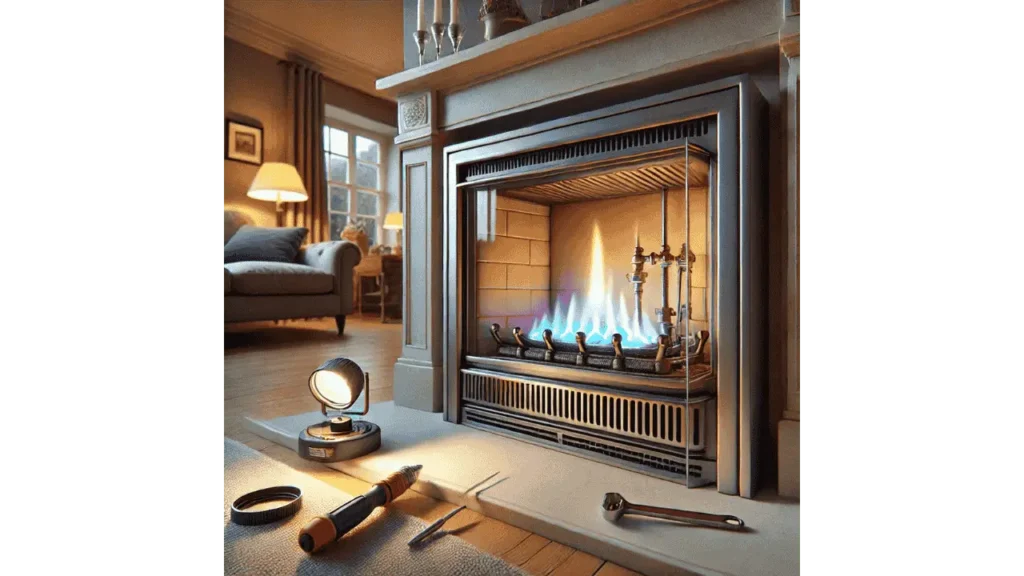Understanding your gas fireplace’s pilot light might seem tricky, but it’s crucial for keeping your fireplace running safely and efficiently. Many homeowners struggle with pilot light issues without knowing how to address them properly. In this guide, we’ll explain what a pilot light is, its key roles, and how you can maintain it effectively. We’ll also cover the differences between pilot lights in traditional and modern gas fires and show you how to spot a healthy pilot light. Armed with this knowledge, you’ll be able to keep your fireplace in top condition, ensuring warm and worry-free enjoyment all winter long.
What is a pilot light?
A pilot light is a small flame that continuously burns, serving as an ignition source for gas appliances, including fireplaces. This little flame is crucial because it ensures that your gas fireplace can start up quickly and safely whenever you turn it on. In my years of inspecting and repairing fireplaces, I’ve found that understanding the role of the pilot light is the first step to troubleshooting many common fireplace issues.
What does the pilot light do?
The primary function of the pilot light is to ignite the gas released into your fireplace, allowing it to burn cleanly and efficiently. Without the pilot light, initiating this process would require manual lighting each time, which is less safe and far less convenient. From my experience, a well-maintained pilot light is key to consistent fireplace performance, preventing gas leaks and ensuring that your unit operates as intended.
Do gas fireplaces have pilot lights?
Most traditional gas fireplaces come equipped with a pilot light, but the type of pilot light can vary.
Traditional gas fireplaces
Traditional models typically use a standing pilot light that burns continuously, ensuring the fireplace is always ready for use. This method is very reliable, although it can be slightly less energy efficient since the flame is always on.
Modern gas fireplaces
Modern gas fireplaces might use electronic ignition systems that only activate the pilot light when the fireplace is turned on, which saves energy.
Intermittent pilot ignition
This system, found in some newer models, ignites the pilot light electronically only when the fireplace is in use, combining convenience with energy efficiency.
How to check which one your gas fire uses
Determining which type of pilot system your fireplace has usually involves inspecting the control panel or consulting the owner’s manual. In my work, I always recommend double-checking this during routine maintenance checks to ensure proper functionality.
The role of the pilot light in gas fireplaces
The pilot light might seem like a small part of your gas fireplace, but its role is significant. It’s the heart of the fireplace’s ignition system, controlling the main gas flow and ensuring that your fireplace lights reliably and safely every time.
Advantages of pilot lights
One major advantage of having a pilot light is the immediate ignition it provides, making gas fireplaces convenient and user-friendly. In my experience, pilot lights also contribute to the overall safety of the fireplace by preventing gas build-ups, as the constant flame ensures that any released gas is immediately ignited.
Drawbacks of pilot lights
However, there are some drawbacks. For traditional systems that keep the pilot light on continuously, it can lead to higher energy consumption. This is something many homeowners overlook but can see reflected in their utility bills. Additionally, if the pilot light goes out unexpectedly, it can halt the operation of your fireplace, which requires manual re-lighting, a process that some may find inconvenient.
What should your gas fire’s pilot light look like?
Understanding the appearance of a healthy pilot light is crucial for maintaining the efficient operation of your gas fireplace. A properly functioning pilot light not only ensures safety but also maximizes the efficiency of your fireplace.
Characteristics of a healthy pilot light
A healthy pilot light should have a steady, blue flame with perhaps a small hint of yellow at the tip. The blue color indicates that the gas is burning efficiently with the correct mixture of natural gas and oxygen. In my hands-on work with various fireplaces, I’ve noticed that any deviation from this can signal issues such as a need for vent cleaning or adjustments in the gas flow.
When should you be concerned?
Be alert if the pilot light is predominantly yellow or orange, flickers constantly, or goes out frequently. These symptoms can indicate problems like a dirty pilot tube, inadequate gas pressure, or even air drafts disturbing the flame. Regular maintenance checks can help catch these issues early, preventing bigger problems down the road. If you notice any of these warning signs, it’s wise to call in a professional to ensure everything is functioning safely and correctly.
Bottom Line
Understanding the ins and outs of your gas fireplace’s pilot light is more than just technical knowledge, it’s about ensuring safety, efficiency, and reliability in your home’s heating system. A well-maintained pilot light not only keeps your fireplace ready at a moment’s notice but also plays a crucial role in the safe operation of your unit. Remember, keeping an eye on the color and behavior of your pilot light can help you catch potential issues before they turn serious. Regular maintenance and professional checks are key to enjoying a warm, cozy fire safely. So, embrace the warmth with confidence, knowing you’re well-informed to handle your gas fireplace like a pro!
- 27 Farmhouse Fireplace Ideas That Bring Warmth & Charm - August 18, 2025
- 25 Fireplace Lighting Ideas to Illuminate Your Hearth - August 7, 2025
- How to Replace an Electric Fireplace Switch? - August 5, 2025



